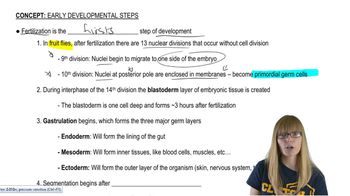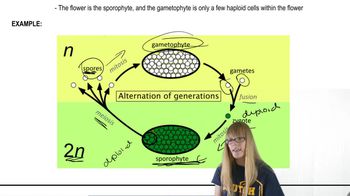In Arabidopsis, which class of HOX genes are responsible for forming the plant carpels?
Table of contents
- 1. Introduction to Genetics51m
- 2. Mendel's Laws of Inheritance3h 37m
- 3. Extensions to Mendelian Inheritance2h 41m
- 4. Genetic Mapping and Linkage2h 28m
- 5. Genetics of Bacteria and Viruses1h 21m
- 6. Chromosomal Variation1h 48m
- 7. DNA and Chromosome Structure56m
- 8. DNA Replication1h 10m
- 9. Mitosis and Meiosis1h 34m
- 10. Transcription1h 0m
- 11. Translation58m
- 12. Gene Regulation in Prokaryotes1h 19m
- 13. Gene Regulation in Eukaryotes44m
- 14. Genetic Control of Development44m
- 15. Genomes and Genomics1h 50m
- 16. Transposable Elements47m
- 17. Mutation, Repair, and Recombination1h 6m
- 18. Molecular Genetic Tools19m
- 19. Cancer Genetics29m
- 20. Quantitative Genetics1h 26m
- 21. Population Genetics50m
- 22. Evolutionary Genetics29m
14. Genetic Control of Development
Developmental Patterning Genes
Problem 4a
Textbook Question
Early development in Drosophila is atypical in that pattern formation takes place in a syncytial blastoderm, allowing free diffusion of transcription factors between nuclei. In many other animal species, the fertilized egg is divided by cellular cleavages into a larger and larger number of smaller and smaller cells.
What constraints does the formation of a syncytial blastoderm impose on the mechanisms of pattern formation?
 Verified step by step guidance
Verified step by step guidance1
Understand the concept of a syncytial blastoderm: In Drosophila, early development involves a syncytial blastoderm, where nuclei divide without forming individual cells. This allows transcription factors to diffuse freely between nuclei, unlike in species where cellular cleavages create distinct cells early on.
Identify the role of transcription factors: Transcription factors are proteins that regulate gene expression by binding to specific DNA sequences. In a syncytial blastoderm, these factors can move freely, influencing multiple nuclei simultaneously, which is different from species with cellularized embryos where diffusion is restricted.
Consider the constraints on spatial patterning: Since transcription factors can diffuse freely in a syncytial blastoderm, the mechanisms of pattern formation must rely on gradients of these factors. This means that precise spatial gradients of transcription factors are critical for establishing distinct regions of gene expression.
Analyze the importance of gradient stability: The formation of a syncytial blastoderm imposes the constraint that gradients of transcription factors must be stable and robust to ensure proper patterning. Any disruption in the gradient could lead to widespread errors in development, as multiple nuclei are exposed to the same environment.
Compare with cellularized embryos: In species with early cellularization, transcription factors are confined within individual cells, allowing for localized control of gene expression. In contrast, the syncytial blastoderm requires mechanisms that coordinate gene expression across a shared cytoplasm, making the establishment and maintenance of gradients more critical.
 Verified video answer for a similar problem:
Verified video answer for a similar problem:This video solution was recommended by our tutors as helpful for the problem above
Video duration:
2mPlay a video:
Was this helpful?
Key Concepts
Here are the essential concepts you must grasp in order to answer the question correctly.
Syncytial Blastoderm
A syncytial blastoderm is a stage in early embryonic development where multiple nuclei share a common cytoplasm without cell membranes separating them. This structure allows for the free diffusion of molecules, including transcription factors, which can influence gene expression across the entire embryo. In Drosophila, this unique arrangement facilitates rapid and coordinated pattern formation, as signaling molecules can easily move between nuclei.
Recommended video:
Guided course

Drosophilia Development
Transcription Factors
Transcription factors are proteins that bind to specific DNA sequences to regulate the transcription of genes. In the context of a syncytial blastoderm, the ability of transcription factors to diffuse freely between nuclei allows for a more dynamic and responsive patterning process. This can lead to the simultaneous activation or repression of genes across multiple nuclei, which is crucial for establishing the body plan and segmentation in the developing embryo.
Recommended video:
Guided course

Eukaryotic Transcription
Pattern Formation
Pattern formation refers to the process by which cells in an embryo acquire different identities and organize into structured tissues and organs. In a syncytial blastoderm, the constraints of having a shared cytoplasm mean that pattern formation relies heavily on gradients of signaling molecules and transcription factors. This can lead to more uniform responses across the embryo, but may also limit the complexity of spatially distinct patterns that can be achieved compared to organisms with individual cell boundaries.
Recommended video:
Guided course

Formation of Plant Gametes
Related Videos
Related Practice
Multiple Choice
514
views
2
rank


